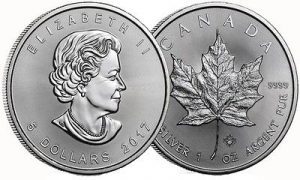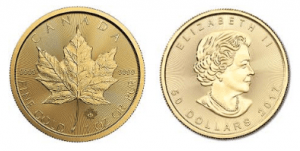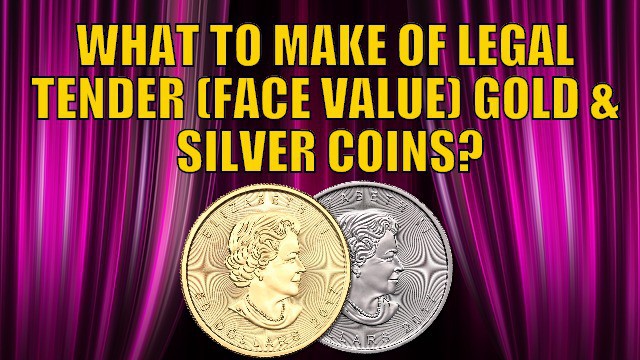In this post you’ll learn all about legal tender gold coins and silver coins including:
Table of Contents
- What is a “Face Value” Coin?
- What is a Non-Circulating Legal Tender Coin?
- Some Examples of Face Value Bullion Coins
- How Do the Mints Arrive at These Coin Face Values?
- In a Currency Failure, Would an Ounce of Gold Therefore be Worth Only 10 ounces of Silver?
- In a Time of Hardship, Would a Country Limit the Spend of a Legal Tender Bullion Coin to the Face Value?
- Should I Buy Legal Tender Gold and Silver Coins?
Here’s a question we received as a result of our 1 oz Silver Coin award. (See How to Win A Silver Coin Every Month for more details on this).
Ross asks:
“Here’s a question for you that I cannot seem to find a definitive answer to…
What do we make of the face values of coins?
Say a silver coin weighing an ounce has 5 dollars stamped on it. How do they come up with that number?
If a gold coin weighing an ounce has 50 dollars stamped on it, again, how did they arrive at that number, and does this necessarily mean that if there was a currency failure, an ounce of gold is only then worth 10 ounces of silver, thus setting the gold:silver ratio?”
What is a “Face Value” Coin?

First up we should explain what a face value coin is.
These are simply coins usually (but not always) issued by government mints. They have a face value on them such as $5 for a silver coin or maybe $50 for a gold coin.
Also known as legal tender coins. Although more correctly they should be called non-circulating legal tender coins.
What is a Non-Circulating Legal Tender Coin?
A non-circulating legal tender coin is able to be used to buy goods and services in their country of issue. Just like a standard government issue banknote or coin. But they are designed more to be collected (or hoarded!).
However while businesses can accept the coins at face value, they’re also free to reject payment via them.
“There’s nothing forcing a bank or a business to accept (the coin),” Reeves says. “If someone offers me a gold Maple Leaf (coin) for $50 face value I’d be crazy not to take it, but it’s still a coin that’s not destined for circulation.”
Source.
However to try and use one of these coins at its face value in a transaction, holders of these coins would have to be horribly uninformed. As you’ll see below, the coins actual metal content value is much higher than their legal tender face value.
Some Examples of Face Value Bullion Coins
The Royal Canadian Mint (RCM) produces the 1 oz silver maple leaf coin. It has a $5 face value even though it contains about CA$45.38 worth of silver at today’s prices. (See this post for more on the silver maple: Silver Maple Monster Box – The Complete Guide)

The RCM also produces a 1 oz gold maple leaf coin with a face value of $50. While its gold content currently is worth around CA$4180.
The US Mint also produces 1 ounce face value gold and silver coins.
The 1oz Gold American Eagle has a $50 face value. While the 1oz silver American Eagle also has a $1 face value. Whereas the actual metal content of them is around US$2925 and US$31.75 respectively.
Closer to home, the Perth Mint has a 1 ounce gold kangaroo coin with a legal tender face value of AU$100. While it is currently worth about AU$4600 based upon the gold spot price. The Perth Mint also has the likes of the Kangaroo silver 1 ounce coin with a face value of just AU$1 but a current metal value of around AU$50.00.
How Do the Mints Arrive at These Coin Face Values?
There doesn’t seem to be any convincing arguments to explain the low face value on the various Mints websites.

For the US Mint coins these values are set by acts of Congress as explained here.
But that doesn’t explain why the face values are so much lower than the metal value.
This FAQ on the Perth Mint Website asks the question: Why Is A Bullion Coin’s Face Value Far Less Than Its Intrinsic Value? But then doesn’t even answer the question it poses!
However this post from Mint employee Bron Suchecki gives a better explanation:
“With the early bullion coins there was a change in face value because it was realised that the face value was too high and if metal prices declined, then the Federal Govt would have to pay out $5 face value when the metal in the coin was less and they would lose money. Face value is basically a floor price which the Govt guarantees to pay you in fiat.
Normal coins have a face value a lot higher than the metal content, multiples higher. The difference between metal content and face value is profit to the issuing Govt. Circulating coins are usually only small value so not much risk to the Govt if metal content value decreases.
Example, lets say the Perth Mint decided to issue a 1oz bullion coin with a face value of $2500 when metal prices were $1500. That $1000 difference would go to Govt as seigniorage profit. Now if the gold price dropped to $1000, then the Govt has to pay you $2500 in fiat but can only sell the metal in the coin for $1000, so they lose $1500. But then they made $1000 on initial issue, so overall would lose $500.
The above example applies to circulating coins, but since we are talking about 10c and the like, and there isnt a lot of dollar value of those small coins out there, the risk to the Govt of a loss if they ever decided to call them in is small. In the case of precious metals, the likelihood of people “redeeming” them for $2500 face value if gold prices fall is high. So that’s why the face value on bullion is less than metal value.
But with a lower face value the Govt still has a risk the metal price could fall lower than face value, so they minimise that risk by putting a really low face value relative to metal prices. Either way the Govt has a risk by putting a face value “guarantee” on a coin, they just prefer to go with the lower face value.”
Source.
Here’s another possible reason why the face value is set so low. To not draw attention to the “canary in the coal mine” that is the price of gold and silver:
“In both Canada and the U.S.; (1-oz) legal tender minted silver coins came into existence in the mid-1980’s, and that was also the time the U.S. began minting its 1-oz gold coins. Canada’s 1-oz Gold Maples came into existence at the end of the 1970’s, but this anomaly was a response to the boycott of South Africa’s (then-apartheid) regime – which (at that time) was producing the only legal tender gold coins in the world.
What is the significance of the start-up date for minting our silver coins? It was shortly after the One Bank had managed to push gold and silver prices all the way from their 1980 peak (when the “canary” was shrieking the loudest) down to the ultra-extreme troughs we saw from the early 1980’s all the way through to today.
The rationality of the seemingly “arbitrary” $1 and $5 face-value on our silver coins is now apparent. It is one part of the strategy by the One Bank for pretending that its (worthless) paper currencies have not lost any value since the assassination of the gold standard. Indeed, it now becomes apparent that it was the fanaticism of these psychopaths with keeping the “market price” for silver equal to the phony face-value on our legal tender coins which has been the banksters’ own undoing.”
Source.
In a Currency Failure, Would an Ounce of Gold Therefore be Worth Only 10 ounces of Silver?

Now onto Ross’s final part to his question. In a currency failure/collapse situation, does this mean an ounce of gold is only worth 10 ounces of silver? ($50 face value gold coin divided by $5 face value silver coin). Or as he said it, would these face values therefore set the gold/silver ratio?
We’d say no, almost certainly not.
The gold/silver ratio is not set by government decree. Well not since the 1800’s when there was a monetary system based upon a gold/silver standard.
To see how the Gold Silver Ratio is calculated, how it can be used, and where it might head to next see: What is the Gold/Silver Ratio?
In a Time of Hardship, Would a Country Limit the Spend of a Legal Tender Bullion Coin to the Face Value?
We also have recently received a similar question from Bronwyn:
“Why do they print a dollar amount on a coin? At a time of hardship, would a country limit the spend of that coin to that amount?”
We would say a government couldn’t really limit the spend as people would simply not exchange them for less than they are worth. Even though these bullion coins have a legal tender face value, you could still exchange them for whatever value two parties were to agree to. Just like today you would be silly to exchange a bullion coin for goods at face value. In the future we doubt people would do that either.
So a gold or silver coin will each be worth what people think they are worth. Not what ever seemingly arbitrary amount has been stamped on them.
In fact in a currency failure/collapse situation, the face value would likely be even more “out of whack” with the actual purchasing power of the coin. That is the amount of goods you could buy would likely be larger than it is currently.
Why?
Because in a currency failure or collapse, gold and silver are likely to be valued much higher than they are currently.
Should I Buy Legal Tender Gold and Silver Coins?
So overall we’d say don’t pay too much attention to the face value or legal tender value of a coin.
Rather as we concluded in this article, consider instead how tradable or exchangeable a coin may be in the future.
Why Premiums Are Important
Also importantly take into account the premium (or mark up) above the spot price of gold or silver you’ll pay. Obviously aiming for as low a premium as possible. In the early stages of the covid lockdowns and amid huge demand, these premiums rose very sharply. Throughout 2021 and 2022 the premiums remained much higher than long term averages.
Lowest Silver Coin Premiums in Memory?
However in the past few months the premiums on silver coins have dropped to levels we don’t recall seeing before. This because we have seen a large increase in people selling so there is a lot of stock available. (Refer to this post for more on that topic: The Two-Tiered Gold Market: Why Central Banks Are Hoarding Gold While Retail Investors Sell Theirs).
In fact right now you can buy a tube of silver maples at a per ounce price that is less than a 5oz silver bar. That is something we haven’t seen before.
You can check out the deals on silver coins for sale here. Or our range of gold coins for sale here.
Currently the best value bulk buys of the well known world mint silver coins are:
The 1oz Austrian Philharmonic Silver Coin, and The 1oz South African Silver Krugerrand, along with the 1 oz Perth Mint Silver Kangaroo Coin.
Or simply phone us on 0800 888 465. Also please let us know if a coin you like isn’t on there.
Editors Note: This article was first published on 9 August 2017. Updated 10 November 2020 to include the question from Bronwyn. Last updated 26 February 2025 to add “Lowest Silver Coin Premiums in Memory?” and updated prices.


What I want to know… Let’s say I’m traveling internationally. For the sake of example, let’s say I’m traveling between NZ and US, with more than $10k cash; I’d be required to declare it. Same thing if I’m traveling with more than $10k in gold bullion, I’d have to declare it.
But what if I’m traveling with ten “legal tender” gold coins, with a face value of $50. Am I traveling with “only” $500 “cash” (legal tender!) which does not have to be declared? Or am I traveling with $12k(US)/$16k(NZ) worth of gold, which does have to be declared?
Pingback: Silver Maple Monster Box - The Complete Guide - Gold Survival Guide
Pingback: "Rules-Based" Monetary Proposals Won't Create Stable Money - Gold Survival Guide
Pingback: Paper Gold vs Physical Gold - What Should You Buy? - Gold Survival Guide
Pingback: Carrying Gold into a Foreign Country. What are the Rules? - Gold Survival Guide
Pingback: Is the Limited Issue Cook Islands Gold Note a Good Investment? - Gold Survival Guide
Pingback: Societal Breakdown: Are Gold and Silver Coins Better Than Tradable Items Like Tools, Water and Wine? - Gold Survival Guide
I’m curious about Atom’s question about declaring the face value when travelling internationally. Isn’t the face value of a sovereign coin all that country accredits the value?
Looks like we missed answering Atom’s question. Sorry Atom. We’d say it likely comes down to whoever the customs officer is you strike at the border. If you look at the currency declaration form you have to complete there is no mention of gold bullion on there. So you could make a good argument that you would have to declare any legal tender currency you have and so you could just declare it if the face value of the coins was over $10,000. However that is a risk to take, as if the coins then get discovered at the border and they take the view you should have declared the value , you run the risk of them being confiscated as stipulated on the currency declaration form. So given there is no GST on most gold and silver coins (except Krugerrands and Gold Eagles), you are likely safer to just declare them. Also make sure you have something proving the purity (although on most coins the purity is also stated on the coins). That’s our 10 cents on it anyway!
Pingback: RBNZ Continues to Try and Stimulate and Dampen the Housing Market at the Same Time - Gold Survival Guide
Revisiting this article… There’s also a bit of history to this. Prior to about 1933 (Executive Order 6102) ≈1ozt gold coins were circulating with a face value of $20, and for a few years after that ≈1ozt silver coins were circulating with a face value of $1; this was an example of “commodity currency”, with the face-value and the melt-value essentially equal. Other countries had similarly valued “commodity currency” gold and silver coins in circulation. Following the advent of central banks issuing fiat currency, well, the rest is history.
Now the fiat currency (which is really “currency”, not really “money”) is actually a “legal tender” fiat “token” of value. Just like an arcade token may be a near worthless plastic disc with an arbitrary value stamped on it, so to are fiat currencies near worthless pieces of base metals or paper or polymer with arbitrary values stamped or printed on them.
token; noun; A token is a round flat piece of metal or plastic that is sometimes used instead of money; A token is a piece of paper or card that can be exchanged for goods, either in a particular shop or as part of a special offer (Collins)
Thanks Atom, yes good the face value of coins was indeed once tied to the actual metal value contained within them. So it’s likely the current face value of some coins is simply a continuation of what has always been stamped on them.
Pingback: US Stock Market to Return Zero for Next 12 Years? - Gold Survival Guide